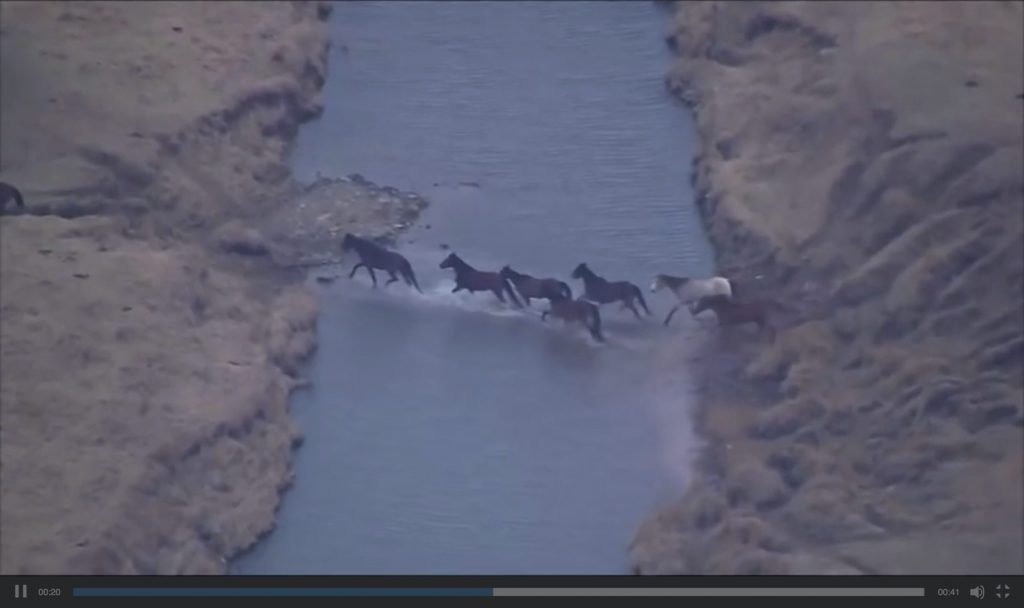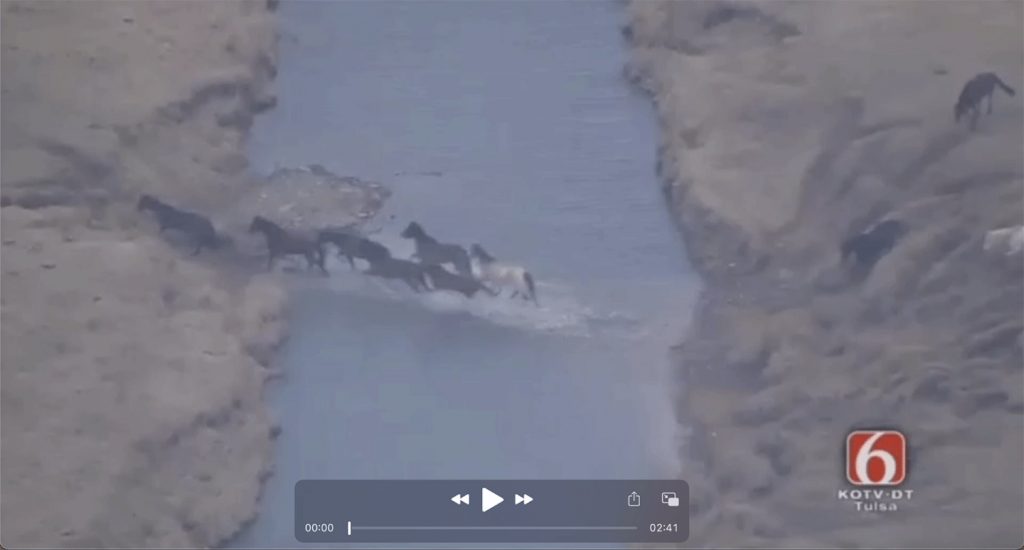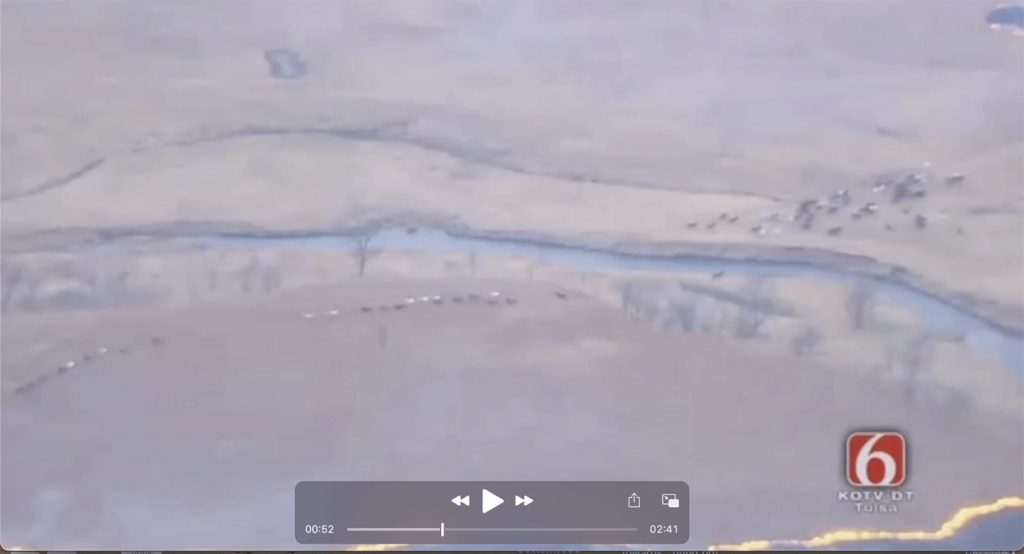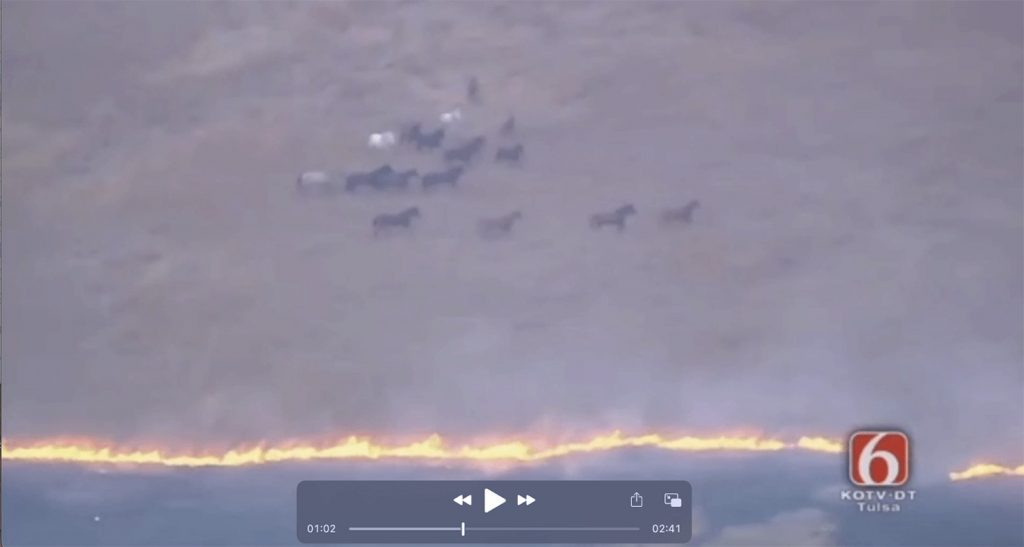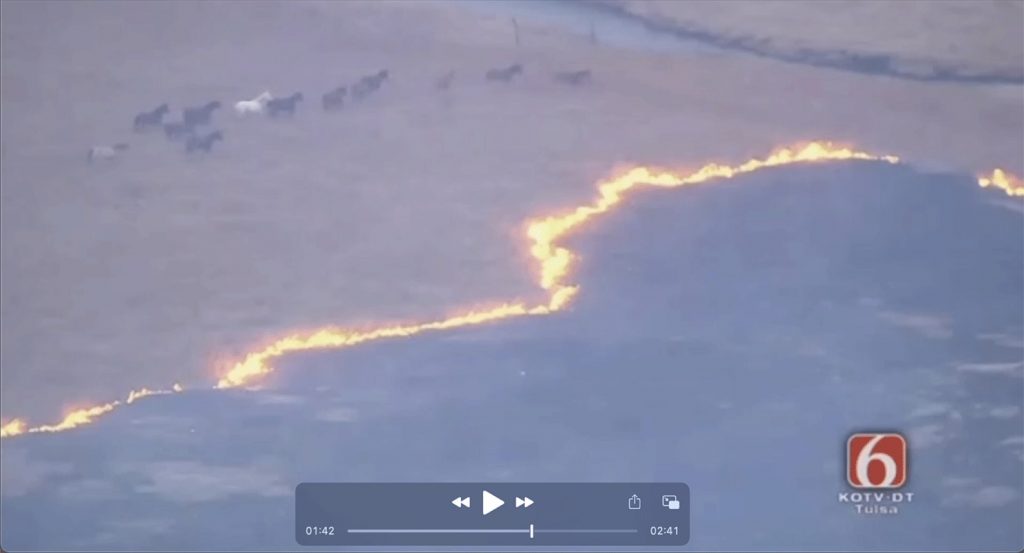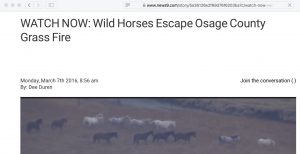 Story is a very powerful way of learning. Stories tell us about those who tell the story. Many of the most important stories Western culture tells convey very important information about Western culture itself: its history, worldview, paradigms and values. Stories the Land tells convey important information about nature’s reality — its history, values, and the paradigm that forms the pattern of the living world.
Story is a very powerful way of learning. Stories tell us about those who tell the story. Many of the most important stories Western culture tells convey very important information about Western culture itself: its history, worldview, paradigms and values. Stories the Land tells convey important information about nature’s reality — its history, values, and the paradigm that forms the pattern of the living world.
Hear, then, these stories of wild horses and wild fire.
In 2016, there was an 11-acre grassfire in Oklahoma. The Associated Press reported the story. Because it’s AP, the story was picked up by other new agencies and run in many news outlets with the same basic headline you see at the top of the still image to the left: “Wild horses escape grass fire.”
The horses in this story were wild mustangs that had been rounded up and then transported to a long-term holding facility in Bartlesville, Oklahoma. So it’s true that they were wild. They had been born and grown to adulthood in one of the federal range areas of Nevada, Colorado, or Wyoming, then caught and shipped to the holding facility in Oklahoma where this grass fire happened to break out.
Two things about the AP video puzzled me when I saw it. For one thing, it told a story of the horses escaping the grass fire as if they’d been afraid of it. For another, the video showed scenes of a herd of horses running parallel to a fireline. You can see a still image of this below. (The original AP video is here but has had advertisements added to it that I don’t want to display in an embedded frame on the Tapestry site.) It’s a bit hard to see the time stamp on the little marker at the bottom of the still image, but it was made 18 seconds into a film that’s 41 seconds long.
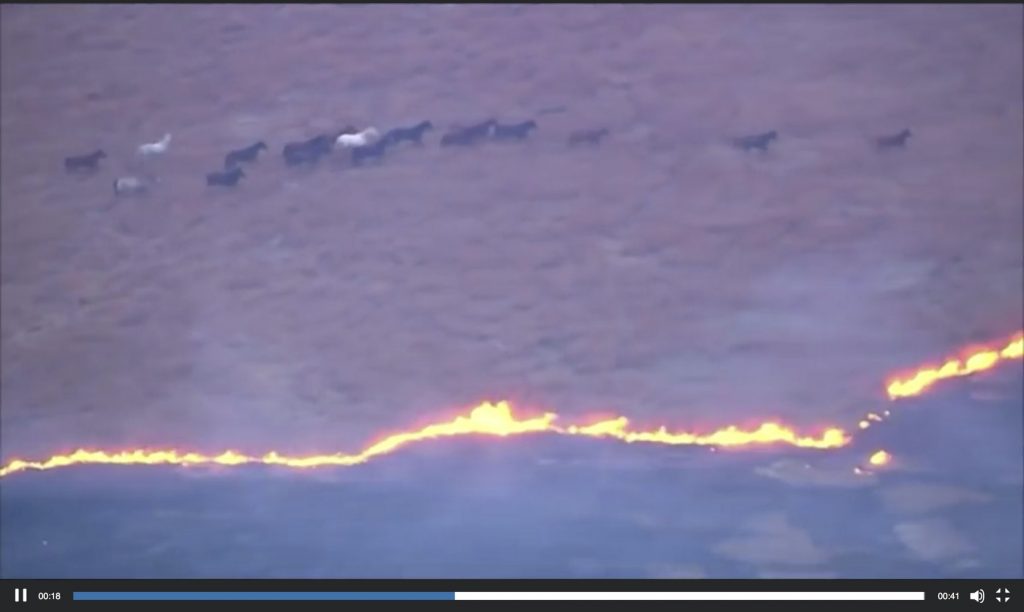
After the frightened horses run past the fire, they apparently find safety by crossing a creek (still image taken at 22 seconds shown below). We watch them crossing the creek for quite a while and there’s a sense in the timing that the horses were crossing it to escape the fire. The rest of the video before and after the key scenes I’ve shared shows several images of horses crossing already-burned grass, others grazing on the far side of the creek, and general scenes of smoke and flames. The basic story overall is the one told in the news headline: that the poor horses were afraid of the grass fire, ran in panic, and that at least some of them found safety by crossing a creek.
The reason I was mystified by this video is that I know how wild horses (and also buffalo) actually respond to grass fire. So what I saw didn’t make sense. In particular, I couldn’t figure out why the horses ran parallel to the fireline for quite a while. When a horse wants to run away from something, it turns its heels to it and goes away. So I started trying to find the original film the AP had edited their story from. The part with precisely the footage that had most puzzled me turned up at Tulsa television station KOTV Channel 6. That video was shot in one continuous loop and clearly not edited or spliced, meaning it’s simply a record of what happened.
The 2 minute and 40 second KOTV film, which you can see here, begins with the horses running across the creek. You can see the time stamp of 00 minutes and 00 seconds on the still image below, from that video. The AP video suggested this was the story’s resolution, remember? But it really happened at the very beginning.
As we keep watching, the horses cross the creek and then run parallel to it for quite a while. 52 seconds into the video, the camera operator zoomed out and now we can see the line of horses making a big arc. The leaders are way over at the far left edge of the image, about a third of the way up from the bottom. A couple of the lead horses are white so you should be able to spot them in the image below. Notice where the fire is in this image, You can see the fireline with blackened grass behind it in the lower right corner of the frame.
As the horses continue running, we see the leaders in front are actually running towards the fire, which we can now see spans the entire area. The group in front heads straight at the flames . . . 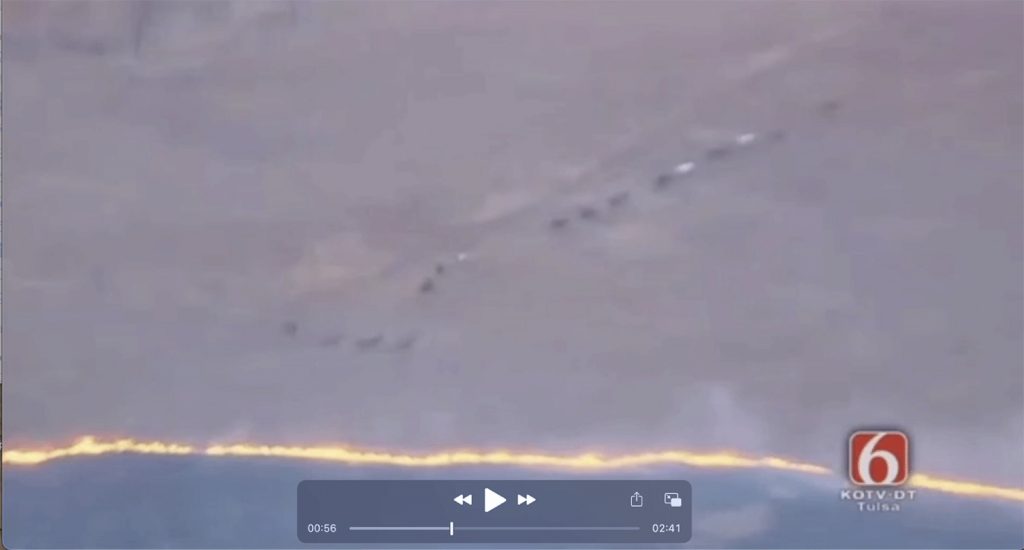
. . . but then pulls up short and starts milling around. It’s clear they could see the flames and smoke this whole time, so if the presence of the fire made them pull up short it’s unclear why they were headed that way to begin with.
As the rest of the herd catches up with the leaders, they all turn and start to run parallel to the fireline.
Eventually we see the horses running parallel to the fireline in the images the AP video used as the beginning to its story about what happened.
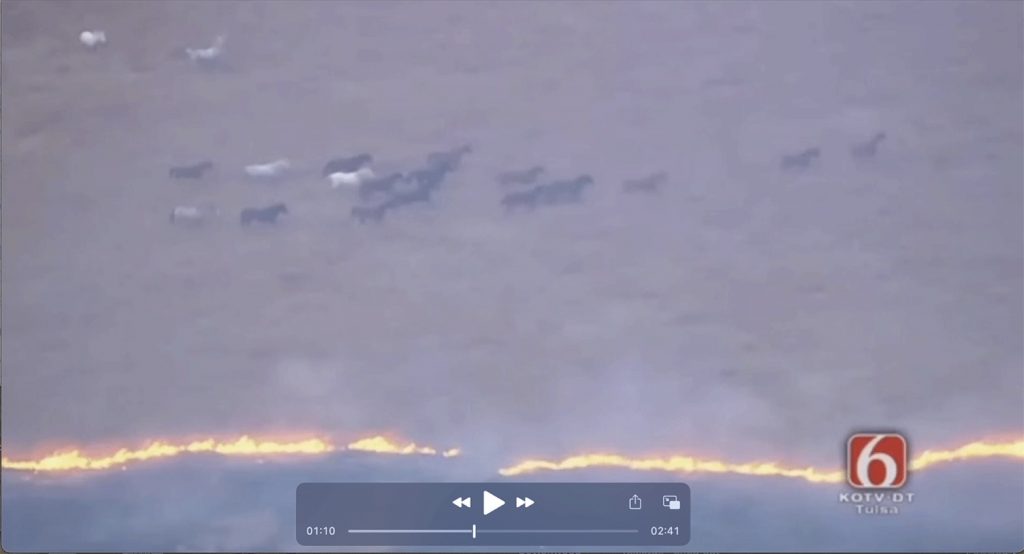
It’s important to notice that at this point the horses have run in a big circle. Seeing the entire video shows us that when they initially crossed the creek, they were not actually running to the side without the fire, but to the side with the fire. Their direction of travel over that creek was exactly the opposite of what was implied in the original AP video. You can see them circling back towards the creek in the still image below.
And a little more than 2 minutes into the original video, the horses squeeze through a narrow area between the fire and the creek they’re coming back to, that they crossed earlier. This squeezing-through is odd if they’ve been running in terror from the fire. 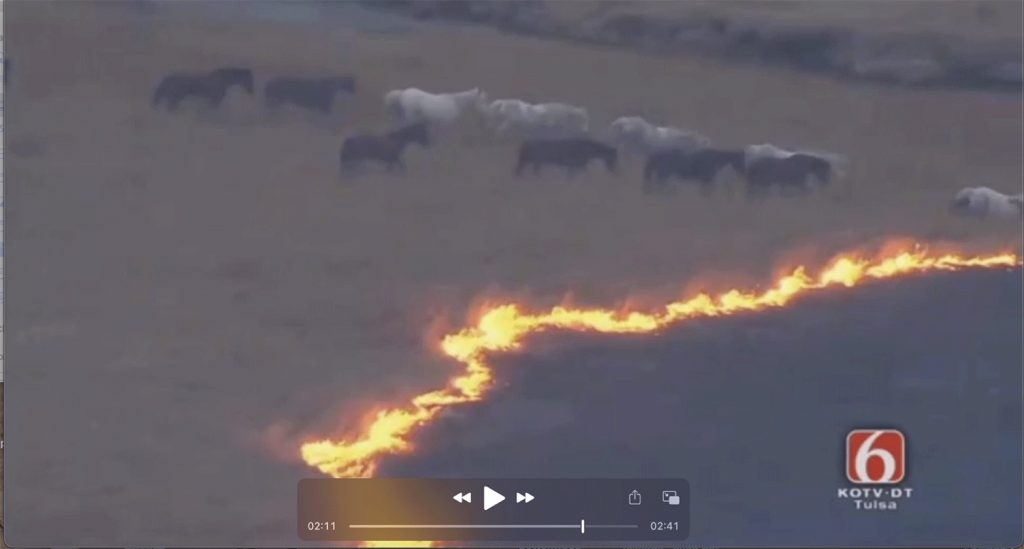
Remember all that space on the other side of them, away from the fire, that they just ran across to get here? If they’re afraid of the flames, why do they run through this narrow area now, that forces them to be so close to the fire, when they could simply run the other way? Once through the tight spot, the horses loop around a tree and cross the creek a second time. 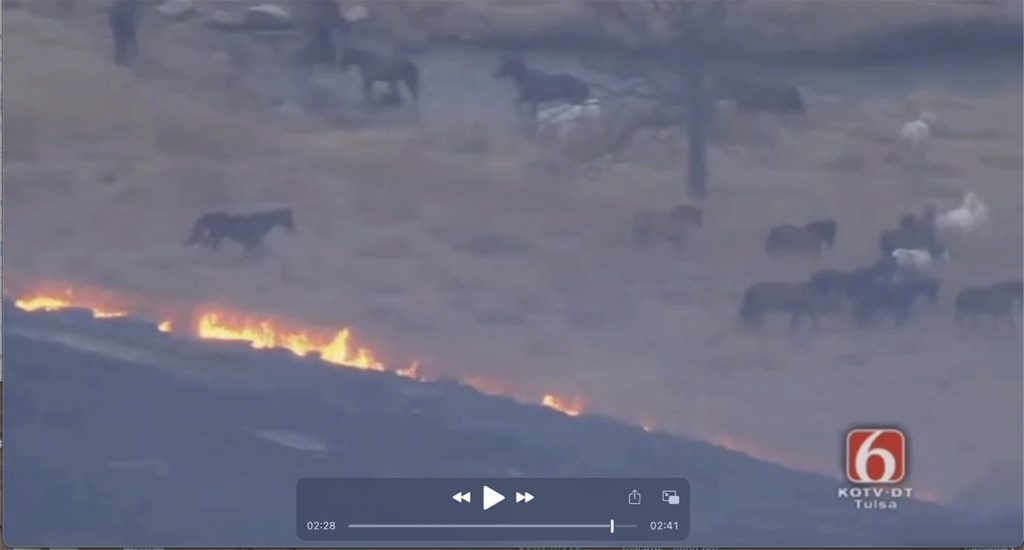
And then, finally, the horses actually run away — the way horses really do this. They turn their heels and GO. Do you see the difference? It’s pretty noticable.
 That’s where the video ends. The horses have run in a big circle back to their original starting point on the other side of the creek. Only now we know that crossing the creek wasn’t about getting away from the fire at all.
That’s where the video ends. The horses have run in a big circle back to their original starting point on the other side of the creek. Only now we know that crossing the creek wasn’t about getting away from the fire at all.
So what’s the real story here, that the Land itself is telling us?
Let me tell you another story of wild horses and wild fire (and of buffalo and fire, too).
We had a wildfire at the place we used to partner with in our work, about 50 miles west of where we are now. We had buffalo and very wild mustangs in a canyon rim pasture there. And those buffalo and mustangs did what Indigenous Elders know they do when fire burns through the grass like this. They face it and calmly jump over the flames to the burned side. Their hooves protect their feet from the hot blackened ground where the grass has already burned and the flames have gone out. Grass fires are a part of the prairie, just as much as buffalo and horses and sideoats grama and the wind. But on an open prairie, fire can burn for many miles. A horse or buffalo that tries to outrun it can’t. It would very likely run itself to death if it tried. But if a horse or buffalo turns and faces the fireline and simply jumps it, the danger is over. Yes, it’s now in a place of burned grass with nothing to eat for a while, but that’s going to be true no matter what after a grass fire. And the fact is that the grass grows back much better after a fire, and pretty quickly. So the animals simply accept the temporary shortage, as calmly as they do the rest of it. That’s resilience.
But people of Western culture see wildfires as bad and scary things. So news reporters and also news-watchers projected that judgment onto the Oklahoma grass fire and thought the mustangs must be running in terror from the flames. Because that was the story in their own heads, that’s what they saw. And AP edited the video to tell that story. But, as we see in the original unedited record, that’s not the story at all.
But there’s still the puzzling matter of the horses running parallel to the fireline. What was going on there? And why did the horses keep running at all, if not from the fire? Why, when they ran across the pasture towards the fireline as if to jump it, did they pull up short and then run along next to, and parallel with, the flames?
Let me ask you a question: How did this film get made?
We dug to find out for sure, so I can tell you: it was shot from a helicopter. The helicopter was hovering over the burned area of the fire, just behind the fireline. You can see its position from the images above. Now, here is the part of the story you probably do not know. In the wild areas of North America where mustangs live, they are rounded up by . . .
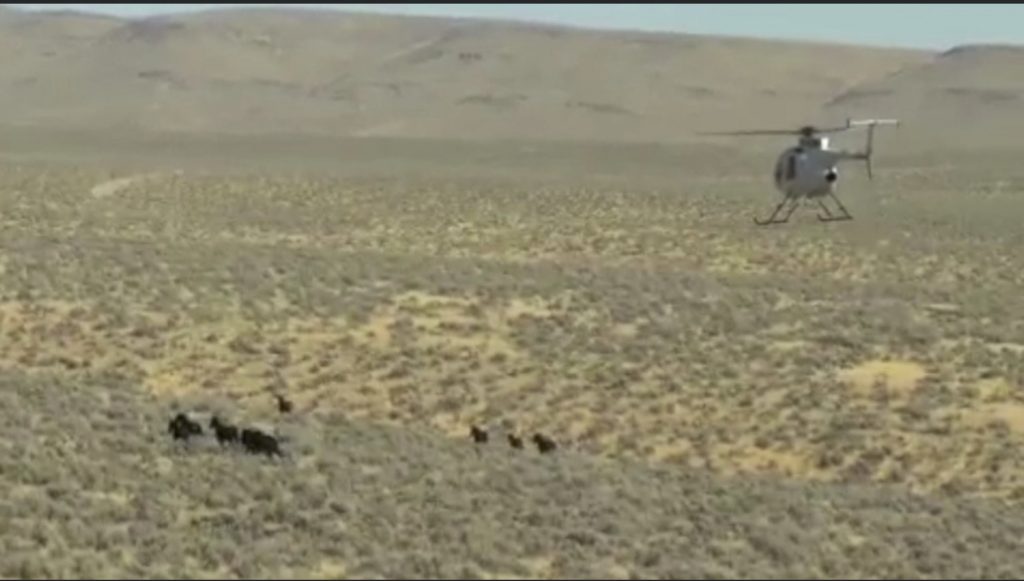
. . . helicopters. The mustangs in the Oklahoma fire video had also been caught wild this way, because ALL mustangs are rounded up and captured this way. That’s simply the way it’s done.
The horses are chased from the air for 10 to 20 miles and then herded into pens. The helicopters come down very low to frighten them enough to force them into the chutes they fear because of the confinement.
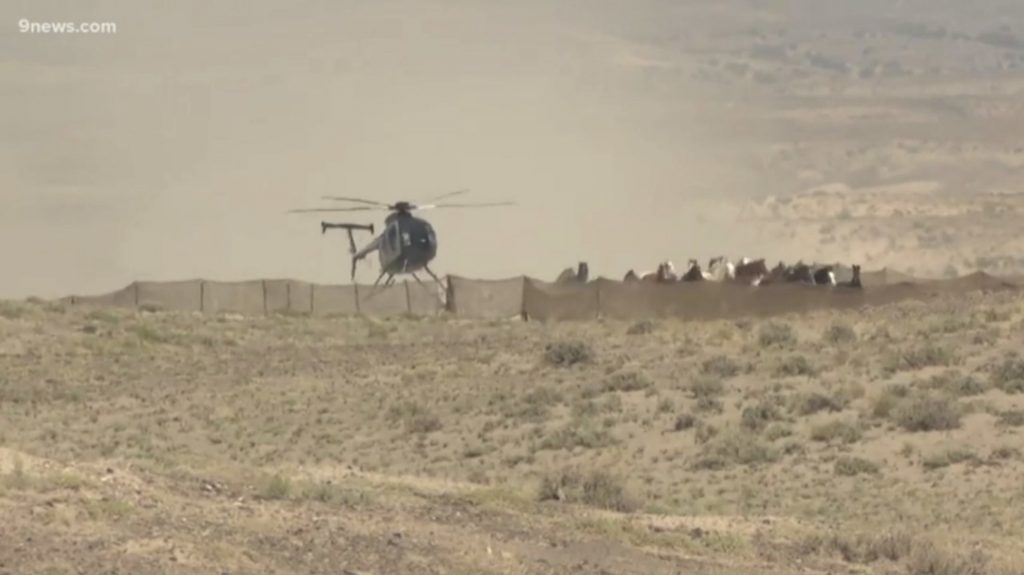
Once the horses are run through the chutes into pens, they’re separated from their herd mates, branded, and the males are all castrated. The terrified horses often try to escape during the lengthy process, and many injured, some some fatally, in the attempt. (They will sometimes try to run right through metal pipe fencing at a full run, for instance, and break their necks as a result.) Of course all these events terrify the other horses even more. And the helicopters are what pushed them into the situation. So all wild-caught mustangs fear helicopters. We have a herd of them we have gentled, who partner with us in our work. When a helicopter or even a small plane goes over, they still run in panic.
The horses in the video were not afraid of and running from the fire at all. They were afraid of and running from the humans and the helicopter carrying them. They crossed the creek the first time because they were fleeing the news helicopter arriving on scene to film the fire. That’s why they were actually running towards the fire when they crossed the creek that first time. The helicopter was arriving on scene and heading for the fire itself, so it inadvertently herded the frightened horses in its own direction of travel towards the fire.
Then the horses ran far enough into the pasture with the fire in it that they approached it to jump to the safe side of the flames — but met the helicopter hovering above the fire when they got there. So they tried to get away from it again. That’s what they are running from as they parallel the fireline for such a long time (you can watch it on the video), is the helicopter itself. But it’s still pursuing them — to film the story (!) of “horses running from a fire.” So the horses just keep on running from it, all that long time they run parallel to the fireline. At the end, they squeeze between the fire and the creek to get away from the helicopter at last, crossing the creek a second time to go back where they had been to start with. In the very last scene we see them finally able to run away from the helicopter. . . and the people inside it who were filming a story that wasn’t at all what they thought it was.
Western culture prides itself on objective observation. Was there objective observation in this situation? No. But it’s not because the news people somehow were not objective enough.
It’s because human beings cannot help but be participant observers — because we are part of the natural world, of the Land. This is the important true thing about the natural world, and we humans who are a part of it, that the Land tells here. The horses, the fire, the grass, and even the buffalo who were part of the story as it told itself to us many years ago are all agents of the Story’s telling.
Human beings are participant observers.
This is true whether we know it or not. What’s dangerous is not knowing it. If you don’t know you’re part of the story you think you’re merely “observing,” you make up and project a story onto the natural world and it’s the wrong one. You want to protect wild horses by suppressing fire, for example, when the fire isn’t the problem at all. The humans involved were and are the problem. This happens a lot and it’s the source of a great deal of trouble.
This pair of videos teaches us a real and extremely important thing about relational knowledge. It’s literally impossible for humans to be objective because objectivity is an ontological impossibility. Objectivity requires separation, and we are not separated from the natural world, but a part of it. The Corps of Engineers officers in charge of the Mississippi River have been fighting with that river for years, never realizing that it’s not a fight they’re engaged in but a dance — one where they are leading and the river is following them, responding the way a dance partner does. The river actively replies to every step they take, the same way that water and sand respond to a stone that tumbles into a mountain stream or that surf and sand respond to your feet standing in the tidal zone. In a dynamic system, relationships exist and are THE significant factors in the system. Changing anything generates complex responses in everything else. And humans are active participants in these complex systems so every single thing we do changes literally everything else around us in response. The more we react in panic to those changes and so do even more, the more the complex system of which we are a part follows our lead by going in the extreme direction we, ourselves, are leading it.
This is why we say the world comes with a built-in real value system of relational accountability. We have to pay enough attention to the consequences of our actions to realize that we are the ones initiating all of the environmental problems we’re facing right now — and that the panicked “fixes” we try to implement are simply more of the same, not anything new or different. Relational accountability is not merely a concept. It is an ontological law of nature, the same way that gravity is.
As for this particular Story, perhaps we can see that we owe it to the horses, the grass, and the fire not to impose our judgments and story on their reality. The reality is that fire keeps the grasslands healthy and the horses and buffalo know how to handle it. When we judge, then we try to control things. It is suppressing grass fires that has made prairie lands overgrown with brushy fuels that now burn in devastating ways.
Please hear this Story told by the living heart of Indigenous Knowledge.
—–
An important note about a species of invasive grass. The impact of fire in Western grasslands of North America is presently being altered by invasive cheatgrass, which was not present in the Oklahoma location pictured above. Cheatgrass is not native to this continent, and it has a very different burn regime. It produces much hotter and much taller flames. It also burns more frequently and, because of the heat it produces, tends to destroy local native vegetation which it then replaces even more completely upon regrowth. Prairie mammals that are adapted to burns cannot easily jump a line of cheatgrass flames. The incursion of this invasive species into Sonoran desert habitats that never previously burned has even led to massive wildfires on those deserts. Cheatgrass is spreading and has so far been resistant to efforts to stop it. This invasive species does not change the relationship between native wildfire in grasslands and the animals adapted to it, but instead introduces a disruptive element to the system that creates serious problems.
Click here to return to the list of pages at Weaving the Basket.
Click here for list of References.

